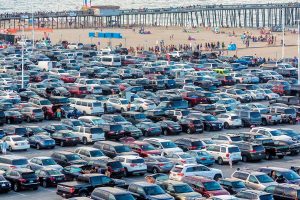
OCEAN CITY — Is the new Inlet lot pay-up-front parking system causing some visitors to scurry back to their vehicles before their night of enjoyment on the Boardwalk and downtown is done?
That’s a question the Mayor and Council had before them on Monday and the short answer is there are different ways to add more time when parking on the Inlet lot. The challenge is not everybody is aware of the alternative methods to add more time, but it has become apparent many are leaving early because of concerns about their paid parking expiring.
Before the start of the summer season, the traditional gated system at the Inlet lot came down and was replaced with a new state-of-the-art, pay-by-plate system with license plate reader (LPR) technology. Now, residents and visitors enter the lot and pay up front for the parking time they anticipate using either one of the many kiosks situated on the lot or through the associated Park Mobile app on their phone or mobile device.
Essentially, visitors can pay up front for the time they expect to use and then add more time if they are enjoying the Boardwalk or beach longer than they anticipated. However, it appears there is a learning curve with adding more time and many are scurrying back to their vehicles even when they are still having a good time and would like to stay longer. Councilman Wayne Hartman broached the subject during Monday’s meeting.
“I’ve heard from a couple of business owners on the Boardwalk many visitors feel like they’re being rushed back,” he said. “Before, they would come on the lot and pay when they left they paid for how much time they spent. Now, they are paying for two hours or three hours or whatever, and they are rushing back when the time is up.”
Hartman said he went down to the Inlet to view the system first hand and to discuss some of the issues with business owners.
“There are signs everywhere that say pay upon arrival,” he said. “I think we need to change the messaging to something like pay for your entire stay before you depart so people don’t feel the need to leave if they are having fun. Not everyone uses the app.”
Currently, there are multiple ways to pay for parking at the Inlet including the kiosks and the app. In addition, every vehicle that enters the lot has its license plate read by the LPR cameras and if they choose not to pay at all, or run over the time they paid for, the LPR cameras read their plates again on the way out and visitors and residents can be billed through the mail for the time they used. There is an administrative fee tacked on to bills mailed. If the mailed bills are not paid, then the notice becomes a citation.
Regardless of what method one is using, Hartman said the system shouldn’t discourage visitors from staying longer.
“I think we need some message like ‘park, play and pay’ or something like that so we encourage people to do whatever they want to do for as long as they want to do it,” he said. “They can pay part at the beginning, then pay the rest at the end if they go over. It seems people are being rushed away because of the time they paid for up front.”
Mayor Rick Meehan said this is the first season with the new system and any bugs or quirks could be revisited when the summer is over.
“At the end of the summer, we need to have a recap for how the new parking system worked,” he said. “We can look at any nuances we need to address and any new ideas can be revisited at that time.”
Meehan said the easiest way to utilize the new system and add more time if necessary is through the app.
“We need more and more people using the Park Mobile app which allows them to add more time from anywhere,” he said. “And you’re right, we need to educate them that they can add more time at any time if they feel like they’re going to exceed their limit.”
Regardless of how they pay, Hartman said it was imperative the public understands there are options for adding more time.
“The public needs to know it’s not important when they pay for the time as long as they pay before they leave and pass the camera on the way out,” he said. “We don’t need to do anything other than get the message out that people need to pay for their entire stay but they can add more time at any time during their stay. That way, there is no pressure to get back if they’re on the Boardwalk or wherever they are. Not everybody uses the app.”
Councilman Dennis Dare said the apparent confusion on how to add more time was considered when the new parking system was designed and implemented.
“When we discussed these changes, this situation of people hurrying back was part of that discussion,” he said. “It only took until the middle of July to figure this out.”
Dare agreed a stronger message on how to add more time was likely needed, but cautioned against a broad-brush campaign. He pointed out while the pay-by-plate system is in place on the streets and other municipal lots, those areas are not equipped with the LPR cameras that can catch overages.
“I have one word of caution going forward,” he said. “We have the same system at the Inlet lot as we do on the street and the other parking lots. If you publicize this at the Inlet lot, people may become confused about doing it on the street and on the other lots.”

